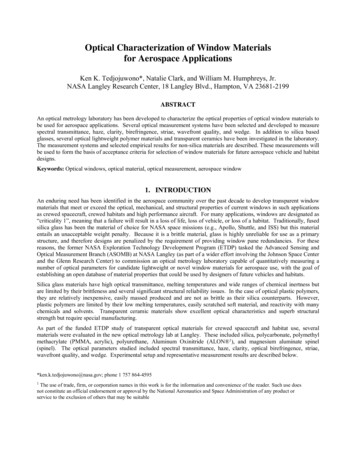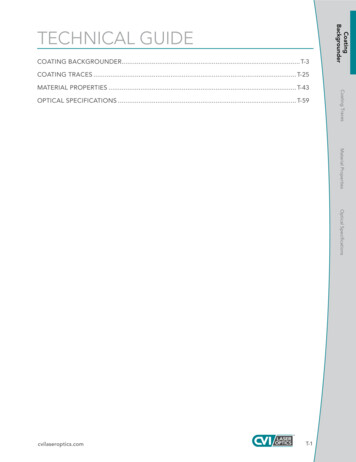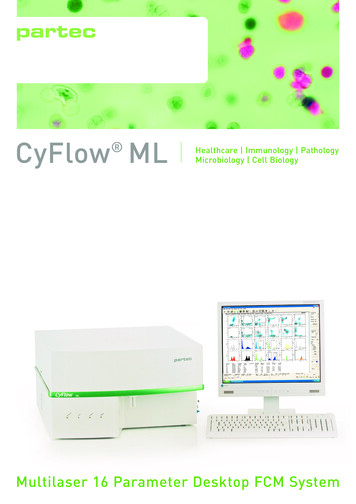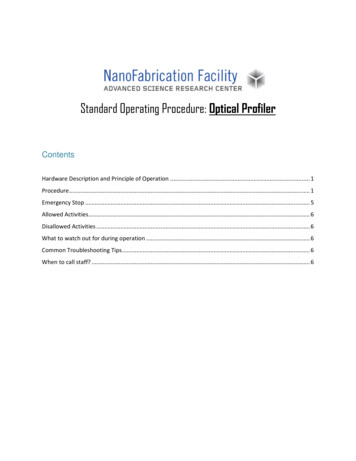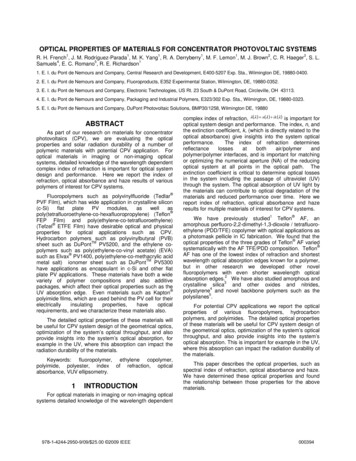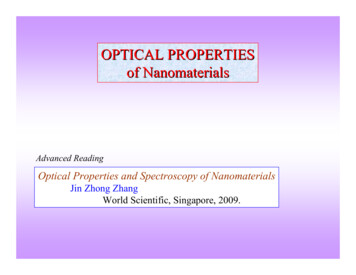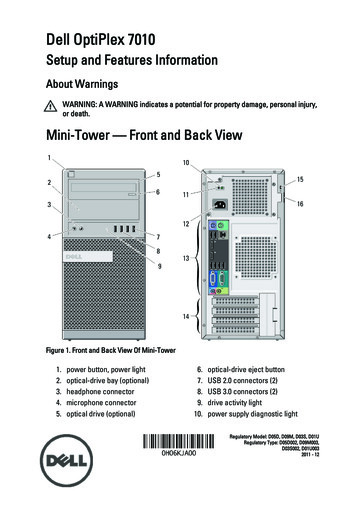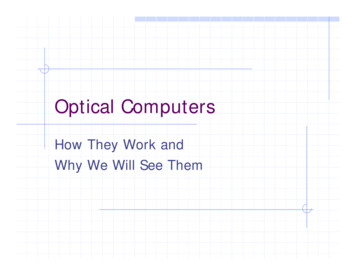
Transcription
Optical ComputersHow They Work andWhy We Will See Them
Why We Need ThemMoore’s Law states that the number of transistors ona computer chip doubles every eighteen months.Traditional transistors can no longer keep up. Too many transistors will slow down processor speeds.Transistors have physical size limits.Metallic wires limit the speed of transmission.Resistance per unit length in the chip is beingincreased, causing more power usage and excessheating.
What Is an Optical Computer?An optical computer is a computer that performs itscomputation with photons as opposed to the moretraditional electron-based computation.There are two different types of optical computers. Electro-Optical Hybrid computersPure Optical computers
Silicon Vs. Optical Computers
Basic Path of InformationThrough an Optical ComputerInformation gets sent in from keyboard, mouse, or other externalsources and goes to the processor.Processor then sends the information through logic gates and switchesto be programmed.The information is then sent through different fiber optic cablesdepending on it’s final location.Some information will be sent to the holographic memory, where it willthen be saved.After information is saved and the program would like to use it, theprogram sends a command to the processor, which then sends acommand to receive the information.The program receives the information and sends a signal back to theprocessor to tell it that the task is complete.
Electronic Computer
Optical Computer
Electro-Optical HybridUse optical fibers and electric parts to read and directdata from the processorLight pulses send information instead of voltagepackets.Processors change from binary code to light pulsesusing lasers.Information is then detected and decodedelectronically back into binary.
Pure Optical ComputersUse multiple frequenciesInformation is sent throughout computer as lightwaves and packets.No electron based systemsNo converstion from binary to optical necessary,greatly increasing the speed.
Lenslet’s Optical ProcessorFirst programmableoptical processorCombines optics,silicon, communications,and tools in standardboardSoftware tools allowsmooth developmentpath
Optical TransistorsTransistors based off of the Fabry-PerotInterferometer. Constructive interference yields a highintensity (a 1 in binary)Destructive interference yields an intensityclose to zero (a 0 in binary)
Constructive Transistor
Destructive Transistor
Digital Optical Logic GatesLiquid Crystal LightValve (LCLV) Uses a liquid crystaldevice and aphotoconductor.Programmable throughapplication of a writebeam, causing thepolarization of thereflected beam tochange.
Optical Logic GateSelf Electro-optic EffectDevice (SEED) Change in voltagechanges absorptionproperties in quantumwell layers.StackableSmall sizeLow powerEasily madeCompatible with standardfabrication techniques forcurrent logic gates.
All Optical Logic GateThis is an All optical logic gate based on Interferencefringes, which the detector reads, and then sends theinformation through to the correct program.
Optical Vs. Electrical SwitchesChange the direction ofpropagation for thetransmitted wave.Allow information to beused in other parts ofthe computer.Non-linear opticalproperties of materialsare used to redirect thepropagation of one lightusing another controllight.Made out ofsemiconductors.Change direction ofbinary code throughwires.Toggle Switch (canchoose between twodirections)LAN Switch fornetworking
All Optical SwitchesAnalog Gimbal-Mirror Switch Direct light into highernumber of ports withoutmuch loss of informationNo need to waste timeconverting from optical todigital.Problems include; tightlypacked mirrors, mirrorcontrol algorithm, fiber andlens arrays and mechanicalpackaging.
Optical FibersAdvantages Small in sizeLow transmission lossesNo interference fromradio frequencies,electromagneticcomponents, or crosstalkSaferMore secureEnvironmental immunity
Interconnection of Optical FibersAdvantages BandwidthindependenceNo capacitive effectsNo interferencebetween parallel wavesLow power constraintsIncreased flexibilityDisadvantages. CostSizeAlignment precisionThermal stabilityFabricationLack of designsoftware for creationNeed ultra lowvoltages
Holographic MemoryA holographic memory can store data in theform of a hologram within a crystal.A laser is split into a reference beam and asignal beam.Signal beam goes through the logic gate andreceives informationThe two beams then meet up again andinterference pattern creates a hologram inthe crystal.
Holographic Memory
Advantages to OpticalComputingSmall sizeIncreased speedLow heatingReconfigurableScalable for larger or small networksMore complex functions done fasterApplications for Artificial IntelligenceLess power consumption (500 microwatts perinterconnect length vs. 10 mW for electrical)
Limiting Factors for OpticalComputersOptical fibers on a chip are wider thanelectrical traces.Crystals need 1mm of length and aremuch larger than current transistorsSoftware needed to design and run thecomputers.
What Exists AlreadyBeam splitters which move light in array bysilicon being placed at different angles.Stacking with banyan switches,allowing formore programming combinationsCrossover switches which are used in digitalcameras.Photodiodes which convert light into electricalcurrent.A Variable Electro-Optical Mirror, created byHudson Research, Inc.
How we use fiber optics nowWe currently use DWDM(dense wavelengthdivision multiplexing) fiber optics for datatransfers betweens cities.Corning is making fiber optics to the homeavailable for high speed internet connection.Optical Spatial Filters are used for medicalimaging, using Fourier Analysis to sharpen animage, such as an X-Ray
Images Using Optical Spatial FiltersUnfiltered ImageFiltered Image
What is Probable to See in theFutureOpto-electronic in natureUse direct analogy of presence orabsence or signals from a medium.Many lasers will be able to travelthrough one pathway, making the traveltime within the computer much faster.
Spatial Light ModulatorsThere are six major groups. One-dimensional Optical / OpticalOne-Dimensional Optical / ElectricalOne-Dimensional Electrical / OpticalTwo-dimensional Optical / OpticalTwo-Dimensional Optical / ElectricalTwo-Dimensional Electrical / Optical
Optical Vs. Electrical Switches Change the direction of propagation for the transmitted wave. Allow information to be used in other parts of the computer. Non-linear optical properties of materials are used to redirect the propagation of one light using another control light. Made out of se


